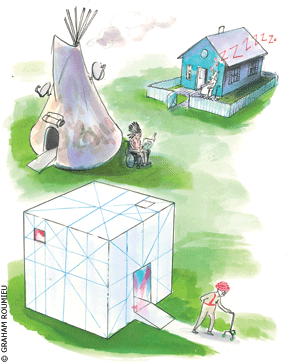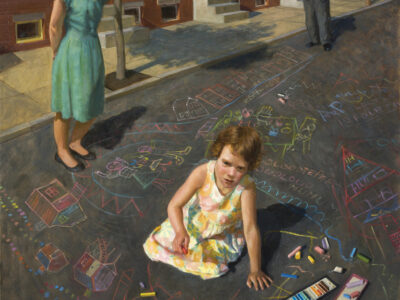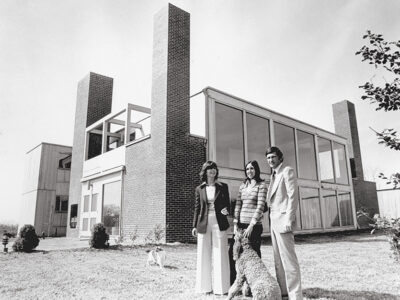
“What a drag it is getting old,” Mick Jagger once sang—and a recent Penn Design conference gave the aging rocker yet another proof of his lyrical prescience. The Rolling Stones front man was evoked repeatedly during an October symposium exploring what you might call the architecture of old age.
“New Aging: International Conference On Aging and Architecture” brought together about 300 architects, students, and others to discuss topics ranging from new trends in nursing-home design to “empowered aging” programs for seniors who are still on their own.
Sponsored by the Jacob Rose Family Foundation, participants gathered for two days filled with daunting statistics (by 2030, one-fifth of the US population will be over 64), fountain-of-youth proclamations (physical decline can not only be slowed, it can be reversed!), and more cynical takes on such high-flown claims (the anti-aging industry, one skeptic noted, has spun a dizzying array of lotions and potions into an $8 billion enterprise). The speakers ranged from a gerontologist to a filmmaker to a landscape architect, and they hailed from places as diverse as Germany, the United Kingdom, and Slovenia.
“I was 25 years old a minute ago,” said 41-year-old Sylvana Joseph—on hand to promote Gramma Sutra, a humorous look at sex and aging she co-authored with J.G. Sandom. “And I’ll be 65 years old a minute from now. Aging is not a crime, but not having a plan is.”
It was a theme sounded by even the most youthful of attendees. “When I worked as a caregiver during college, I started getting excited about the notion that maybe design could better support those with memory and physical losses,” said Heather Bachman, a graduate student at Clemson University’s program in architecture and health. As she researches trends in adult day-care facilities, her 60-something parents admonish her “to do a good job,” she laughed. “Whenever I visit a nursing home, I ask myself: Would they like to live here?”
The usual answer is, of course: Not really. And that was the impetus for the conference, according to Matthias Hollwich, its organizer. “Ninety five percent of our experience is architectural,” said Hollwich, a studio instructor in Penn’s architecture program who became interested in the intersection of aging and design when his private practice was approached about an LGBT retirement community in Palm Springs. “There are 17,000 nursing homes in America,” he added as the conference got under way, “and 17,000 reasons not to move into them.”
Although the thrust of the conference was on working toward more palatable alternatives for senior housing, Hollwich kicked off the first evening of the event with a selection of non-architects asked to share their own views on what growing old should or will look like in the future.
“So, are you ready to age?” Hollwich asked.
The question these presenters most seemed intent on answering, though, was: How will tomorrow’s seniors try to stay forever young? Will they fight their impending frailness with magic creams and pills, throw their hopes behind genetic manipulation, or pursue some other futuristic innovation that promises to keep them vital and even extend their lives?
Aubrey de Grey, co-author of Ending Aging, argued that scientists should make the title of his book a real goal. A biomedical gerontologist with a lilting British accent and a full red beard that streams to his chest, de Grey chastised those who would “forget that aging is a bad thing,” and laid out a case that it isn’t inevitable. Research into areas such as stem cells hold the promise of an ever-extended life span, he exhorted.
But Arlene Weintraub C’89, a journalist who’s covered the pharmaceutical industry for Business Week and is the author of Selling the Fountain of Youth, was having none of it. Taking the podium, she railed against an industry that “made a disease of getting old—and made billions.” Her presentation included video of an appearance by Suzanne Somers on The Oprah Show, where the actress declared her devotion to bioidentical hormone replacement therapy, and laid out the 60 or so supplements she ingests daily.
“It scares me every time I see it,” Weintraub said.
Then it was time for Jagger’s first appearance. The moss that’s grown on this famous Rolling Stone showed up in a presentation that compared his time-ravaged face with his less-craggy younger self. “Look what can happen to you even if you take really good care of yourself,” quipped biotech entrepreneur Greg Stock, to a huge roar of laughter. (Stock’s company, Signum Biosciences, investigates therapeutic candidates for Alzheimer’s, Parkinson’s, and other conditions.)
“Are the inventors of sex, drugs, and rock-and-roll going to go to Florida and laze by the pool, drinking cocktails with little, tiny umbrellas?” asked industrial designer Jose Colucci Jr. “I don’t think so.”
One alternative idea came from Barbara Trimble, a registered nurse who detailed the offerings of her company, Extended Family, which allows members to become part of a personalized “wellness support” group that delivers services—from bill paying to healthcare support to grocery shopping—right to their homes. “It’s taking the idea of the village movement and giving it muscle,” she said. “It’s an empowered aging program that makes sure that elements like the environmental, physical, social, medical, and legal are in order.”
Architects ruled the day, though. Victor Regnier, a researcher and architect at the University of Southern California, presented a look at housing models in Northern Europe designed to work for everyone, regardless of their age or mobility. In places like the Netherlands and Scandinavia, he said, seniors are able to stay in their own homes longer, while services—such as meals-on-wheels and home care visits—are delivered to them, and ramped up as needed. Such communities are often designed in accordance with the principles of New Urbanism, which include clustered housing and centralized common spaces, such as exercise facilities, located within walking distance. He suggested that these sorts of “non-institutional solutions” are one way to go.
Erhard Kinzelbach, an architect at the New York-based firm Knowspace, introduced a project commissioned by the Austrian government that rejiggered traditional nursing home layouts and public spaces. He began by illustrating what was initially requested of him by his bureaucratic client: one square with a smaller box placed in a corner (representing an apartment with its bathroom), repeated 50 times.
Given the limits of the private spaces provided for residents, then, he decided to experiment in other ways, reexamining facades, interior and exterior common spaces, and corridors. His innovations included lower interior windows that allow the bedridden to still enjoy views; creating several smaller gathering rooms instead of just one large one; and fashioning expansive gardens and terraced outdoor cafes. Like many of the day’s case studies, the result was far removed from the drab institutionalism of the typical long-term care facility.
Daniel Cinelli of New York-based Perkins Eastman, a firm that specializes in designing senior housing, said that too often such facilities are more interested in selling real estate than lifestyle. After they’ve eagerly highlighted their common spaces and slate of entertainment options, the discussion, he said, usually degenerates into “do you want the 700-square-foot or the 1,400-square-foot apartment?”
Cinelli suggested that these institutions should instead consider customizing their living spaces, to help potential residents feel more comfortable with the transition from single family living. As an example, he said, designers could draw up apartments tailored for different, theoretical occupants—such as “loves to cook,” “works from home,” “is a messy painter”—that would feature spaces configured to those hobbies and interests. After determining the special needs of prospective residents, managers would simply mix and match from their pools of available homes.
As did several speakers, Emi Kiyota, a Japanese-born architect—and founder of the Washington nonprofit, Ibasho (Japanese for “a place where you can feel like yourself”)—spoke movingly of her grandmother’s experience in an elder-care facility. Kiyota, who lived in nursing homes as part of her graduate research, encouraged her peers to embrace the Zen of “imperfection.” Standard-issue nursing homes can be convenient, efficient, systematic, and hygienic, she observed—but it’s our messy and chaotic homes that we cherish.
Expanding on the theme of getting rid of the impersonal, Dutch architect Arnoud Gelauff presented a graphic that showed a small, childlike-drawing of a cozy home gradually becoming engulfed by a world of needles, wheelchairs, and pills: the hospital model upon which the typical nursing home is based. He offered, by contrast, a slide of his 75-year-old mother ascending a ski lift, and then, as the afternoon wound down, introduced yet another image of Jagger. White shirt collar open, shaggy hair flying, an indefatigable Mick pranced next to the word Satisfaction!
“This man is shouting out,” observed Gelauff. “He is a spokesperson for
his generation.”
–JoAnn Greco




